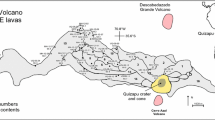Abstract
A 34 meter section of ash- and scoria-fall units has been studied on the upper NE flank of the active Volcán Colima. Charcoal and soil horizons are restricted to the topmost 12 m. Nine 14C dates show a smooth progression from 235 years near the surface to 8,300 years at 10 meters depth, indicating a post-Pleistocene accumulation rate of 1.3 m/1,000 years at 6 km from the vent. This figure allows an estimate of the magmatic eruption rate for fallmaterial of 0.31 km3/1,000 years, less than 15% of Colima's lava eruption rate. An unusually thick and coarse-grained scoria-fall horizon at about 4 m depth in the section appears to have been produced by the caldera-forming eruption of Colima some 4,300 years ago.
The majority (40) of 46 analyzed scoria and ash horizons are typical Colima hornblende-andesites with an average SiO2 content of 58%, nearly identical to the scoriae of Colima's 1913 pyroclastic flows. The scoriae are significantly more basic than Colima's andesitic lavas, which average 61% SiO2. The six remaining scoria horizons are anomalously alkalic and rich in incompatible elements. Five coarse alkaline scoria layers occur in sequence just below the 8,300 year level. They show progressive upward increases in K, P, Ba, Sr, Zr, La, Ce, and related elements, culminating in a phlogopite-bearing scoria horizon.
Over the last 20,000 years or so, a group of cinder cones erupted 20–35 km to the north of Volcán Colima, producing basic alkalic magmas including basanites and phlogopite-bearing minettes. The alkaline scoriae of the studied sections probably record pre-eruptive injections of minette magma into the subvolcanic, calc-alkaline system of V. Colima. The age, composition, and mineralogy of the alkaline scoriae are consistent with this interpretation. Least squares mixing models suggest 60 wt.% minette component in the phlogopite-bearing horizon.
Similar content being viewed by others
References
Aramaki S (1979) Iwanami-shoten. Earth Sci 7:72, Tokyo
Baker PE, Holland JG (1973) Geochemical variations in a pyroclastic succession on St. Kitts, West Indies. Bull Volcanol 37:472–490
Carmichael ISE (1967) The iron-titanium oxides of salic volcanic rocks and their associated ferromagnesian silicates. Contrib Mineral Petrol 14:36–64
Demant A (1979) Vulcanologia y petrographia del sector occidental del eje neovolcanico. Univ Nal Autón México. Inst Geol Revista 3 (1): 39–57
Luhr JF (1981) Colima: History and cyclicity of eruptions. Volcano News 7:1–3
Luhr JF, Carmichael ISE (1980) The Colima volcanic complex: I. Postcaldera andesites from Volcán Colima. Contrib Mineral Petrol 71:343–372
Luhr JF, Carmichael ISE (1981) The Colima volcanic complex: II. Late-Quaternary cinder cones. Contrib Mineral Petrol 76:127–147
Perlman I, Asaro F (1969) Pottery analysis by neutron activation. Archaeometry 11:21–52
Sarna-Wojcicki AM, Shipley S, Waitt RB Jr, Dzurisin D, Wood SH (1981) The 1980 eruptions of Mt St Helens, Washington: Areal distribution, thickness, mass, volume, and grain size of air-fall ash from the six major eruptions of 1980. USGS Prof Pap 1250:577–600
Ui T (1981) Dry avalanche — Mechanism of eruption, transportation and deposition. IAVCEI Symposium on arc volcanism, abstr pp 388–389, Tokyo
Voight B, Glicken H, Janda RJ, Douglass PM (1981) The 1980 eruptions of Mt St Helens, Washington: Catastrophic rockslide avalanche of May 18. USGS Prof Pap 1250:347–377
Waitt RB Jr, Dzurisin D (1981) The 1980 eruptions of Mt St Helens, Washington: Proximal air-fall deposits from the May 18 eruption — stratigraphy and field sedimentology. USGS Prof Pap 1250:601–616
Waitt RB Jr, Hansen VL, Sarna-Wojcicki AM, Wood SH (1981) The 1980 eruptions of Mt St Helens, Washington: Proximal air-fall deposits of eruptions between May 24 and August 7, 1980 — stratigraphy and field sedimentology. USGS Prof Pap 1250:617–628
Waitz P (1906) Le volcan de Colima. 10e Congr Geol Intern, Mexico, Guide excursion XIII: 28
Wells PRA (1977) Pyroxene thermometry in simple and complex systems. Contrib Mineral Petrol 62:129–139
Wilcox RE (1954) Petrology of Paricutin Volcano, Mexico. US Geol Surv Bull 965-C: 281–349
Wright TL, Doherty PC (1970) A linear programming and least squares computer method for solving petrologic mixing problems. Geol Soc Am Bull 81:1995–2008
Author information
Authors and Affiliations
Rights and permissions
About this article
Cite this article
Luhr, J.F., Carmichael, I.S.E. The Colima volcanic complex, Mexico:III. Contr. Mineral. and Petrol. 80, 262–275 (1982). https://doi.org/10.1007/BF00371356
Received:
Accepted:
Issue Date:
DOI: https://doi.org/10.1007/BF00371356




